Modern sales and marketing have brought us the concept of attribution – the process of answering “what activities are the best at bringing us sales?”
We ask because we have a problem: a limited amount of funds to spend acquiring customers. By tracking the path from prospect to customer can we get enough data to tell us where we should move that money around so we are spending as much as possible on the things that work best.
In the beginning, this was one of the benefits to making the transition to a CRM system. Instead of every sales guy having a (paper!) folder on their desk for each prospect and customer, you’d have a record that you could tag with a source code when uploaded.
Being able to run a report at the end of the quarter to see the source codes on the closed won and lost was a miracle, and even now this is a good way to get a better idea of where to be spending your money. In my experience (for better or worse, now containing a sample size of significance), the lesson the CRM ends up teaching is counter-intuitive – you rarely see any sources that are runaway successes that you can dump your whole budget into, but you do find ones where you can say “We never saw a single thing from that program, let’s test something else.”
Eventually, marketing departments wanted to take this a step further. It’s not enough to know what door the lead came in, you’d also want to know what did you do to get the lead all the way to “Closed Won.”
Thus began a sad dark time, a point where things got significantly more complicated, but not a whole lot better. The same technology boom that made things easier to track made the buying process insanely more complicated (mobile, desktop, website, email, digital ads, social media, pay per click, every point requiring somebody to build an integration.) CRM systems added things like Campaigns or other tagging methods where you could mark what a lead/prospect/customer had done or been subjected to (Webinar anyone?) At the same time, web analytics systems also added the ability to track campaigns, goals, and spends which often may or may not (probably not) have been integrated with everything else.
On the web analytics front Avinash Kaushik is famous for having put an insane amount of brainpower behind this, with this post of 2013 being a classic:
https://www.kaushik.net/avinash/multi-channel-attribution-modeling-good-bad-ugly-models/
In 2016 it was expanded beyond just the attribution models, but as a map to get to the highest levels of understanding of attribution. I’m not even going to share that link because there’s no value in us beginning to panic. I know this when I get to this line:
“You can see that the initial elements are pretty small, then things get complicated, but it is not an even distribution. If you do Step 4, Step 5 might actually take less time. It is also clear that things get insanely hard as you get towards the end. Insanely hard is putting it mildly.”
The fact the Stephen Hawking of Google Analytics is saying “Insanely hard is an understatement” is enough for me to go home, cry, and hide in a bottle of tequila until the pain goes away.
And Stephen Hawking is a relevant metaphor because everything above is discounting the massive Black Hole in the room – just because you are mapping the customer path you are not forcing the customer to buy. There are significant factors that affect the sale that are external to your attribution models – budget, politics, staffing, champions, all things needed to get to a brand new customer. These are all a unique black box for every lead. No two companies are the same. The easy answer is that because we have no visibility here we just presume that we can zero it out by analyzing only deals that are Closed Won.
This is the source of our pain. Even if everything on our side is perfect and the budgets are optimized there’s still no guarantee of success.
Ok, you’ve made it this far (or your eyes have glazed over and I can pull you back with the bold text). If you’re just getting started here’s Part 2: Source Codes and Reconciliation








3 thoughts on “Attribution Part 1: Why light up the dark data around attribution?”